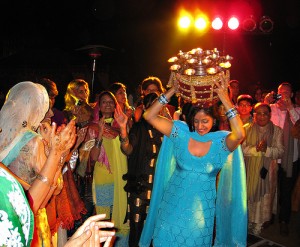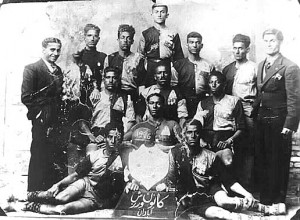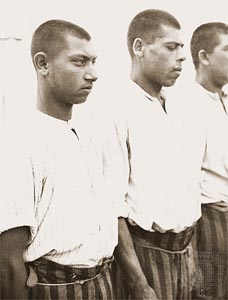by Ranbir
In India the preference for lighter skin is well known. In Bollywood lighter actresses such as Katrina Kaif find that the right skin tone outweighs talent and ignorance of Hindi. Skin lightening products do roaring trade. But what lies at the root of all this? Many people assume it is because over three thousand years ago India was invaded by lighter skinned Indo-European speakers known as Aryans. But this idea was actually manufactured by German Indologist Max Muller in order to justify British rule. As Marx said if Indian history was merely that of a series of invasions, then the question was not if foreigners would rule India, merely which set of invaders imposing their rule. Muller later retracted his thesis saying that by ‘Aryan’ he meant language and not race. But by then the damage had been done and to this day the idea remains regretfully mainstream and is rarely challenged unlike the Hamitic Invasion Theory of Africa which dates to around the same period but has now been dropped for the racist idea it was.
When ‘Brother-in-Law’ means Rape
If we cannot blame the aforementioned non-existent ‘Aryans’ then could it be due to two centuries of British colonialism? Certainly this favoured lighter skin and there was even a mixed race of Anglo-Indians deliberately created as a buffer between the Raj and the masses. But anyone familiar with Indic languages knows that the preference for lighter skin just seems too deep. For example in Punjabi the phrase “kali mu vaaliya” (one with black face) has extremely derogatory connotations. No, we must look at other clues in this search.
Released in 1975 Sholay remains among the greatest films of Hindi cinema. One cinema in Mumbai ran the movie for 286 weeks straight (more than five years). Dubbed a ‘curry western’ Sholay achieved a still-standing record of 60 golden jubilees (50 consecutive weeks) across India and may well have been the highest grossing film ever produced by Bollywood. Now it is the famous scene of Russian roulette we are concerned with here. Leading a band of dacoits, Gabbar Singh (played by Amjad Khan) puts a pistol to the head of three of his men who are sent back empty handed from the village of Ramgarh. Putting the gun to the head of his first subject Gabbar pulls the trigger only to find the chamber empty. He utters the now immortal words “bach gaya saala” in his menacing voice. This is usually translated into English as “the bastard survived”. But in Hindi and Punjabi the word ‘saala’ does not mean ‘bastard’. It means ‘brother-in-law’. So how to explain this? Using the exact translation would not make sense. But in the cultural and linguistic context it makes perfect sense. The term ‘saala’ can be one of family endearment. But in this and many other contexts is means something very specific, namely ‘I slept with your sister’. This also implies ‘you can now take her back’.
In his 1992 book Negationism in Indian History, Belgian scholar Koenraad Elst mentions this:
“It is because of Hanifite law that many Muslim rulers in India considered themselves exempted from the duty to continue the genocide on the Hindus (self-exemption for which they were persistently reprimanded by their mullahs)….. The Moghul dynasty (from 1526 onwards) in effect limited its ambition to enjoying the zimma system, similar to the treatment of Jews and Christians in the Ottoman empire. Muslim violence would thenceforth be limited to some slave-taking, crushing the numerous rebellions, destruction of temples and killing or humiliation of Brahmins, and occasional acts of terror by small bands of raiders. A left-over from this period is the North-Indian custom of celebrating weddings at midnight: this was a safety measure against the Islamic sport of bride-catching.”

Jaago, meaning “wake up” a marriage folk dance in the Punjab, taking place at night where girls dance through the village streets carrying a pot (gaggar) decorated with lightened candles and singing jaagu songs.
It is the last sentence that should interest us because it explains why ‘saala’ is such an abusive term. In fact it is merely the tip of a massive politically incorrect and rarely explored iceberg.
The Blackness of Servitude in India
In his 1994 book The Muslim Slave System in Medieval India, KS Lal has detailed how right from the invasion of Muhammad bin Qassim in the seventh century Hindus were subject to enslavement as an integral part of Islamic conquest, rule and forcible conversion. Females were especially targeted to fill the harems of sultans and their nobles. As mentioned by Dr. Elst, this is the origin of Hindu marriages being celebrated at nigh. It also led to jauhar, the mass self-immolation by which Rajput women preserved their honour rather than be capture. This was done by lighting a huge fire in a pit into which women and children then jumped in order to avoid rape and enslavement.

The Akbarnama portrays Jauhar or the self-immolation on fire by Rajput women during the siege of Chitor, 1567
In more recent years similar desperate action was taken by Sikhs avoiding humiliation through rape and forcible conversion and marriage when Pakistan was formed. For example in the village Thoha Khalsa of Rawalpindi District in 1947 only three women survived because there was not enough water in the well to drown them as they sought to evade capture by Muslim marauders intent on exterminating the unbelievers in their midst. What Pakistan perpetrated on its Hindu and Sikh inhabitants from its very inception was merely a replay of centuries of Islamic colonialism, genocide, demographic upheaval and cultural dislocation. It was something that was to burst with full fury in 1971 as East Pakistan fought to break free as the independent state of Bangladesh. The Pakistani military and ruling caste was from the west composed of mainly Punjabis and Pathans such as Ayub Khan who saw their darker-skinned Bengali eastern brethren as mere Hindu converts to Islam, while they were descendants of great conquerors such as the Mughals.
Indeed the Islamic conquests were constantly wracked by internal racial strife. Afghans, Arabs, Turks and Iranians occupied the higher echelons of government. Hindu converts and African slaves were considered as inferior. Lal:
“D.B. Davis in his Slavery and Human Progress attempts to estimate the number of blacks that would have been sold as slaves and imported into India. According to him “the importation of black slaves into Islamic lands from Spain to India constituted a continuous large-scale migration that in total numbers may well have surpassed, over a period of twelve centuries, the African diaspora to the New World”. The absence of a large population of black survivors can be explained by their high mortality rate; by assimilation with other peoples; and by the fact that many male slaves had been castrated. Even so in central part of India and on the western coast, there are communities of blacks who are descendants of African slaves. On some Western Coast Islands also there live descendants of black slaves. The Jinjeera Island, so called because of mispronunciation by Marathas of Jazeera meaning island, or Zanzeera meaning land of Zanj or Blacks, is their main abode. It is also called Habsan or the land of Africans or Habshis. In the seventeenth century these islanders, called Sidis of Jinjeera, served as admirals of the Mughals and were at constant war with the Marathas.”
( http://voiceofdharma.org/books/mssmi/ch7.htm )

Indian Siddis or Habshis of Gujarat , Karnataka and Andhra Pradesh are descendants of African slaves imported under Islamic rule
The writer continues:
“However, in contrast to the foreign imported slaves, whose market price was rendered high by cost of transportation and deaths in transit, the price of Hindu slaves, sold abroad remained low. For example, Hindu Kush (Hindu-killer) mountain is so named because thousands of enslaved Hindus died in crossing it. But their numbers were so large that the price of survivors remained low in foreign markets.”
( http://voiceofdharma.org/books/mssmi/ch10.htm )
The Mughals continued this export of Hindu slaves to Iran and Central Asia. Jean-Baptiste Tavernier visited Mughal India during the reign of Shah Jahan in the seventeenth century. He made this observation on the ruling class:
“They were called Moguls, that is, white of complexion . . . the natives being all brown or olive colour.”
The physician François Bernier also noted the skin colour of the ruling elite:
“…to be considered a Mogol, it is enough is a foreigner have a white face and profess Mahometanism.”
The Mughals were in fact Chagatai Turks. But it was the Iranians who dominated the Muslim regime oppressing India’s toiling Hindu masses. The Iranians looked down upon the Mughals and Indians as barbarians and were helped in their superior status by a preference for lighter skin colour. Indeed Bernier said that as successive generations of Iranian immigrants became darker, they lost the respect accorded to newcomers and all fair-skinned Muslim immigrants as part of the ruling class. Italian traveller Niccolao Manucci said that Iranians constantly referred to Indians as “slaves” or “blacks”. Afghans, though part of the ruling class, were portrayed as crude and vulgar.
Racial and ethnic strife had existed from the very advent of Islam, between slaves and free, even between northern and southern Arabs. But the Arabs had always formed a hereditary ruling caste over the vanquished from the time of the Ummayads. Any Muslims who had Iranian, Berber, Aramaen or other undesirable blood was classified as Mawl? and excluded from the dominant racial caste. Strict social barriers were maintained between the Arab ruling racial caste and the non-Arab oppressed masses. Embracing Islam was no escape from this badge of inferiority. While Arabs could take wives from the indigenous people, the converse was not true. The non-Arabs resented their treatment as racially inferior. For example, Mawálí soldiers were led by Arabs generals only on foot with their weaponry being limited to a baton. As a reward for defeating the Ummayad army outside Mosul was to have the Arabs massacre the 7000 mawálíinhabitants of Kufa. From the late seventh century, black slaves from East Africa were used in the marshland of Mesopotamia to cultivate cotton and sugar on plantations. Housed in very harsh conditions of camps of up to five thousand captives, they rebelled in 694 which was crushed. These were known as the Zanj. The Zanj rebellion resulted in extremely racist attitudes towards blacks, as expressed in Arabic literature, by poets of Ethiopian descent, known as the “black crows of the Arabs”, such as Suhaym (d. 660), Nusayb ibn Rabah (d. 726), and Abu Dulama (d. c.776), pointing to clear evidence that black slaves had the lowest position in Muslim society. Racism was in fact as central to Arab slavery as it was in the western system which developed later. Arabs saw their own olive pigmentation as preferable to lighter Greeks and Iranians as well as darker people of the Horn of Africa. Early Arabic poetry describes the many nuances of human coloration. In fact the name of the seventh century poet, Suhaym, literally means “little black man”, and he penned verses such as the following:
“Though I am a slave my soul is nobly free
Though I am black of colour my character is white.”
Nusayb ibn Rabah responded to a racist attack on him by an Arab poet, because he was black:
“Blackness does not diminish me, as long as I
Have this tongue and this stout heart.
Some are raised by means of their lineage; the
Verses of my poems are my lineage!
How much better a keen-minded, clear-spoken
Black than a mute white!”
By the fourteenth century, the Arabic word “abd” as used to mean black slave, while “mamluk” meant a white slave. Black Africa remained a major source of slaves for the Islamic world until well into the twentieth century. Blacks came to be seen as natural slaves when compared to other races. It was this prejudice against darker skin which was imported into India and has been entrenched their over the centuries. But the other legacy of Islamic slavery and racism was even worse.
Hindu Kush means Hindu Slaughter
The numbers of Hindus enslaved and exported from India by various Islamic invaders and imperialists was staggering, to such an extent that it gave the name to the mountains in Afghanistan as so many died en route. In Iran these Indian slaves were forced to work in the mines while slaves were also imported from Africa in huge numbers. In 1849 and 1850, Lady Mary Eleanor Sheil wrote from the British embassy that black slaves known as Nubees or Habshees were highly esteemed and well treated. However racial prejudice appears to have increased after slavery ended, as reported by Joseph Harris in 1967 in several cities. An Afro-Iranian community near Bandar Abbas complained of racism by other Iranians.
As well as colour prejudice towards darker skin in India and Iran, Islamic slavery had other negative influences which are only just being uncovered. In his 1979 book Roma: The Gypsy World, Dr. SS Shashi challenged the belief that Europe’s Gypsies had their origins in any of India’s “untouchable” castes. Instead he traced the Roma to various castes including Rajputs, Banjara, Jat, Ahir, Dhangar, Dom and Sansi. Iranians still refer to Gypsy groups of Indian descent as Luri. Arabs call them Zott while in Syria they are referred to as Nawar. Nineteenth century Dutch historian MJ Goeje wrote that the Arabs brought tens of thousands of Indian peasants from the Indus region as slaves to be settled in Iraq. These Zotts became powerful enough to challenge the Abbasid Khalifate and hence Baghdad sent its forces against them in 820. The Zotts were defeated in 834, and the entire population deported to Syria. South African born scholar and anti-apartheid activist Ronald Segal mentions this slave revolt by the Zotts or Djatts, which he said were Indian slaves deported from the Lower Indus to the swamps of Lower Mesopotamia, to breed water buffalo while living in extremely impoverished conditions, which led to their rebellion. He says that their defeat led to them being deported to various parts of the Abbasid caliphate. This may explain why Gypsy groups of obvious Indian descent remain in the region, continuing to be disclaimed by the Arabs, Iranians and Turks as being part of their respective communities. They are known as the Domari.
Professor Ian Hancock from the University of Texas , scholar of Hungarian Roma and British Romanichal descent, concludes that the Roma are therefore most likely the descendants of high-caste Hindu Rajputs and not the Doms. Romani vocabulary points to a one time settled rather than nomadic population. In India there are nomadic groups such as the Banjara which claim descent from Rajputs, and left their homeland of Rajputana after the defeat by Mahmud of Ghazni in the eleventh century. At the Second World Romani Congress in April 1978, Ranjit Naik stated that Rajputs had fled these invasions into Central Asia. Then in 1998, B Shyamala Devi Rathore submitted a paper at the Romani Studies conference at Greenwich University, in which she mentioned Banjara historians that wrote about Rajputs leaving their homeland of Rajasthan due to the Ghaznavid raids, and spreading out in all directions. Hindu Rajput warriors were captured in warfare by the Ghaznavid Turks who invaded India during the eleventh century. From the Ghaznavids, the Seljuk Turks also took them as slaves. This Indian population then found themselves brought to Europe in the thirteenth century as slaves and also in military battalions by the invading Ottoman Turks. These were to become the Roma or Gypsies. Hancock in his 2002 book We are the Romani People:
“The first Romanies that the Europeans met were very different from any of the local populations – far more distinct than we are today. They were mostly dark-skinned, and wore unfamiliar clothing and spoke a language nobody recognised. They were neither Christian, nor Jewish, nor Muslim and seemed to have no country of their own. And most of all, they were extremely reluctant to let outsiders – the gadže – get too close.”
As the Turks conquered the Byzantine Empire and advanced into Europe, Roma were reduced to slave status. They were also enslaved by the landlords in Christian populations of the Balkans, especially Wallachia and Transylvania. Female Roma were subject to horrendous sexual exploitation right up until the abolition of Gypsy slavery after the creation of the modern state of Romania in 1864. It is unknown how this slavery began. Some may have already been slaves of the Ottoman Turks, or even the Tatars who had invaded Europe earlier. By the early 1300s, Roma in the Balkans were being included as property given as payment, even to monasteries. As non-indigenous people, as non-Muslims, and as slaves, Roma were at the bottom of the social scale in the Balkans, especially in that all conquered non-Muslims could be treated as property. By the sixteenth century, the word for Gypsy in Romanian, tigan, had come to mean slave specifically of Roma origin. For this oppressed minority dislocated from their Indian homeland through distance and the centuries elapsed when their Hindu ancestors had been enslaved by the armies of Islam there was to be no happy ending. Half of the European Roma population died in the Holocaust in what is known in the Romani language as Porrajmos, a powerful world which translates as devouring or rape.















